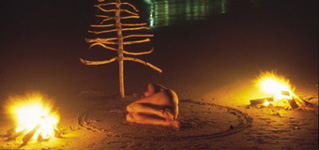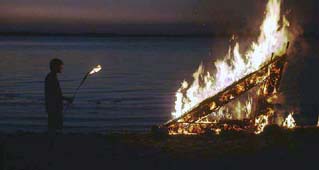|
RiverLights Introduction | Artists| Fire Art| Contact
Fire Art Throughout the ages, human beings have considered fire to stand for warmth, safety and the possibility of life. It has also played an important communal role. Stories have been told by campfires, and through them, the feeling of community and the common worldview have been strenghtened. Fire also has its destructive side, however, which is shown in fires and arsons. Because of its dual power, fire is connected to different types of rituals and beliefs. Finnish examples of communal fire related events are the bonfires at Easter and Midsummer, which today are still a part of a living cultural heritage. The term fire art stands for fire performances and fire sculptures. As forms of art, the performances and sculptures are very different from each other, but it is possible to combine them in the same fire art event. Whereas the English language uses the term fire sculpture, Swedish uses the equivalent eldskulptur or the term eldkonst, fire art. Fire performances, where burning balls are whirled, are known by the international term poi. This form of art comes from the Maori culture in New Zealand. In their traditional dances, the Maori have whirled balls attached to linen strings. In addition to Poi art, the term fire performance can include many kinds of circus art, fire acrobatics using burning torches, as well as fire eating and blowing.
Artist Cherie Sampson creates ritual fire art. Fire art sculptures are built from materials that burn, with the aim of controlling the shape and progression of the fire. When the sculpture is designed, it is already contemplated in what direction and at what speed the fire progresses in the work of art. Commonly used materials are wooden bars, straw, wire gauze and lighter fluid. Wood and wire gauze are used to make frames, which are filled with straw that has been made compact. A fire sculpture can also be built from rags and old fabrics on a wooden or metal frame. A moment before the beginning of the event, the sculptures are moistened with igniting fluid. The work burns from a few seconds up to several minutes when the supporting structures fall apart. The pieces that are left can be burnt in a campfire. The wire gauze and nails that remain unscathed are collected as waste.
The wind is one of the artists in fire art. There are many possible ways to create a fire sculpture. A silhouette-like work of art, whose parts are, say, burning drawings, is the easiest to create. A three-dimensional construction almost seems two-dimensional when it is burning, and the fire draws the shape of the sculpture against the dark sky. In function art, a certain designed function takes place. The work can, for example, include parts which create movement or sound. In a mobile work, the movement is created by carrying it or making it move with the help of some mechanism. 5.9.2005 Maria Huhmarniemi |
|



